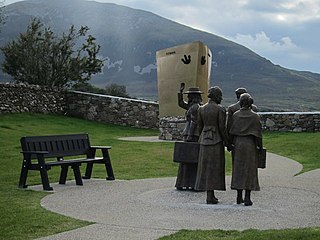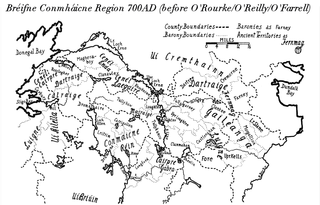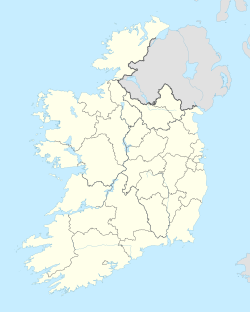
County Mayo is a county in Ireland. In the West of Ireland, in the province of Connacht, it is named after the village of Mayo, now generally known as Mayo Abbey. Mayo County Council is the local authority. The population was 137,231 at the 2022 census. The boundaries of the county, which was formed in 1585, reflect the Mac William Íochtar lordship at that time.

Connacht or Connaught, is one of the four provinces of Ireland, in the west of Ireland. Until the ninth century it consisted of several independent major Gaelic kingdoms.

Castlebar is the county town of County Mayo, Ireland. Developing around a 13th-century castle of the de Barry family, from which the town got its name, the town now acts as a social and economic focal point for the surrounding hinterland. With a population of 13,054 in the 2022 census, Castlebar was one of the fastest growing towns in Ireland in the early 21st century.

Ballaghaderreen is a town in County Roscommon, Ireland. It was part of County Mayo prior to 1898. It is in the north-west of the county, near the borders with counties Mayo and Sligo, just off the N5 road. The population was 1,808 in the 2016 census.

Aidhne, also known as Uí Fhiachrach Aidhni, Mag nAidni, later Maigh Aidhne, was the territory of the Uí Fhiachrach Aidhni, a túath located in the south of what is now County Galway in the south of Connacht, Ireland.. Aidhne is coextensive with the present diocese of Kilmacduagh.

Lahardane, also sometimes spelled Lahardaun, is a village in the parish of Addergoole, County Mayo, Ireland, adjacent to Lough Conn and to Nephin, and close to the towns of Crossmolina, Castlebar and Ballina. The 2016 census recorded a population of 178.

MacHale Park is a GAA stadium in Castlebar, County Mayo, Ireland. It is the home of the Castlebar Mitchels GAA and Mayo GAA Gaelic football teams. Built in 1931, the ground currently has a capacity of 25,369 and is named after John MacHale, Catholic Archbishop of Tuam from 1831 to 1881. It is the twelfth-biggest sports stadium in the Republic of Ireland by capacity and the second-biggest in the province of Connacht after Pearse Stadium in Galway.
The Mayo Senior Football Championship, known for sponsorship reasons as the Connacht Gold Mayo Senior Football Championship, is an annual Gaelic football competition contested by the top Mayo GAA clubs.

Costello is one of the ancient baronies of Ireland. Unusually for an Irish barony, it straddles two counties: County Mayo and County Roscommon. It comprises the modern day districts of Kilkelly, Kilmovee, Killeagh, Kilcolman, and Castlemore.

Mac Siúrtáin, aka Mac Jordan and Jordan, is the name of a Connacht family of Norman-Irish origins.
Miles de Angulo Anglo-Irish knight and baron, fl. 1245–1259.

Joyce Country is a cultural region in counties Galway and Mayo in Ireland. It is sometimes called Partry, after the former tribal territory of the Partraige, which it largely matches. Part of it falls within the Connacht Gaeltacht. Joyce Country lies on the shores of Lough Mask and Lough Corrib, and includes the Partry Mountains. It is a rural area that includes small settlements such as Clonbur, Cong, Cornamona and Toormakeady. It borders Connemara, to its south and west.

Islandeady is a village in County Mayo, Ireland, about halfway between the towns of Castlebar and Westport.

Gailenga was the name of two related peoples and kingdoms found in medieval Ireland in Brega and Connacht.
The Kings of Luighne Connacht were rulers of the people and kingdom of Luighne Connacht, located in what is now County Mayo and County Sligo, Ireland.
The Kings of Sliabh Lugha were rulers of the district of Sliabh Lugha located in what is now the barony of Costello, County Mayo, Ireland.
Ruaidrí Ó Gadhra was an Irish king of Sliabh Lugha and Chief of the Name.
The Ó Gadhra Chiefs of the Name were the heads of the Clan O'Gara, who were originally located in Sliabh Lugha, the southern part of the territory ruled by the Kings of Luighne Connacht. In the 13th century they were expelled from the area and moved to Cul Ui Fionn, later known as the barony of Coolavin, County Sligo.
Ó Gadhra or O'Gara is an Irish surname which originated in the kingdom of Luighne Connacht. Variants include Garry, Geary, Gerry, and Guiry.
Kilcurl comprises the two townland areas of Kilcurl Anglesey and Kilcurl Feronsby. The townlands are situated one mile (1.6 km) from its nearest village, Knocktopher, and located on a road to Carrickshock monument one mile (1.6 km) away and two miles (3.2 km) to Ballyhale. The village of Knocktopher is situated in the parish of Ballyhale, south County Kilkenny, in Ireland.














